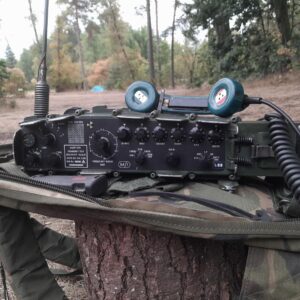Thank you so much to Enzo, I now have a bug. Not been long, but another “characterful” way of sending CW in preference to electronic keyers.
Category Archives: Uncategorized
FISTS Straight Key 8
See here for the current FISTS club activity that is promoting the use of character by a mechanical only keying activity week. Not even Bugs are allowed!
I dug out the old Kent brass pounder I passed the CW test on almost 40 years ago and have been participating this week much to the bemusement of my victims QSO partners.
Character signal from the Low Lands
I had the great pleasure of working Hans, PA2MT last night, on 80M, who was in a caravan in the Low Lands ( de Lage Landen ). He was using a PRC320 Clansman and there was some noticeable chirp but you know how we love a little chirp on this site as it adds true “character” to the signal.
Hans also reports that he was using a leg-mounted key 🙂 Way to go, Hans, however, this makes it impossible to TOF ( try other foot ) as QLF members oft tell each other to do! 🙂
I had worked Hans before; previously he was operating a SEG-15D transceiver, these originated in Eastern Germany where they were manufactured for the Marine/Military markets.

Clansman PRC320
Reverse engineering character into modern transceivers
Leaving aside the subject of drift in free-running VFOs (pre PLL & TCOs ) one regular feature of old CW transmitters, particularly where they were simply high-power oscillators, was the chirp you got as the frequency dipped on key-down whilst the HT re-stabilized.
In an effort to simulate this an audio keyer is being prototyped to bring back those old days. The video shows the first hack ( 20 minutes today ) . The sound is terrible as I have not added low pass filtering to the square wave output and it is playing on a piezo sounder. It is also dual-tone (selectable by design).
The next step is to change the chirp algorithm to natural log as this better mimics the capacitive recovery effect on old HT keyed circuits.
73 G0FOZ
Update – some drift on this one, a different chirp and amplifier stage was added (3rd-order RC LPF too ).

Air key – huff and puff keying
I had the tremendous pleasure of working Wolf ( DL4NCO ) on 20M this month who intrigued me by sending that he was using an “Air Key” and that details could be found on his QRZ page ( see here ).
“The air key, a monitoring pressure switch which is used e.g. at gas burners. The air flow from the mouth is interrupted or released with the tongue to generate cw sigs.”
This definitely demonstrates “CW Character” and hats off to Wolf for this method of keying 🙂
Simon G0FOZ

Codification of fist identification (WWII)
I remember (badly) a discussion some 35 years ago with an aged “G” who remembered a system of codification of transmission style in punched cards at Bletchley during the war. He said that they codified “fists” with certain criteria on punched cards and the you could see if a “newly” identified station was an old operator by inserting rods matching the fist. So you could see if Joe Blogs who used to be a radio op on ship X has moved to ship Y or an operator at Moscow airport was now somewhere else…..
I could not find much on the punched card/rods however similar information on an approach “TINA” is covered in some places on the web. An article on this subject can be found here: Allied Analysis of Electronic Transmissions in WWII by Jerry Proc VE3FAB
Try doing that with a modern TCO stabilised transceiver keyed with an auto-keyer!
Simon G0FOZ

Certificates Issued
The first batch of membership certificates have just been issued to members #0001-#0005
In line with the value “character transcends perfection” they were issued with a spelling mistake such that Wonky keying was rendered Wonyness !!!!
Enjoy the irony.
Simon G0FOZ

Welcome
Welcome to QLF the home of straight key amateurs who love the sound of character and can recognise each other by the “fist”.
QLF – “Are you sending with your left foot? Try sending with your left foot!” A humorously derogatory comment about the quality of a person’s sending”
No auto-paddle-keyer with rock-solid PLL/TCO here. We revel in slight chirps and drifting around the receive bandwidth.
“Wonkyness Transcends Perfection.”
Example of fine work:
We are full supporters of QTT (Quality Telegraphy Time) – Quality not Quantity = Rag Chew not 599 TU.
Free Membership
You get enrolled in the worshipful society of QLF operators (est. 2023) and published to the honour roll; you can see our current member list here:

